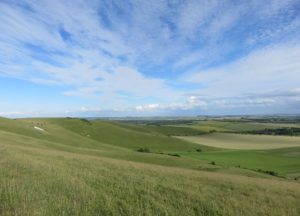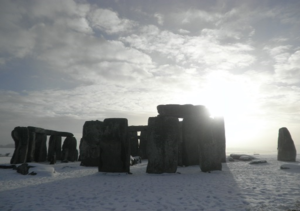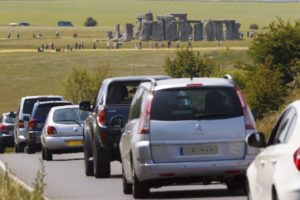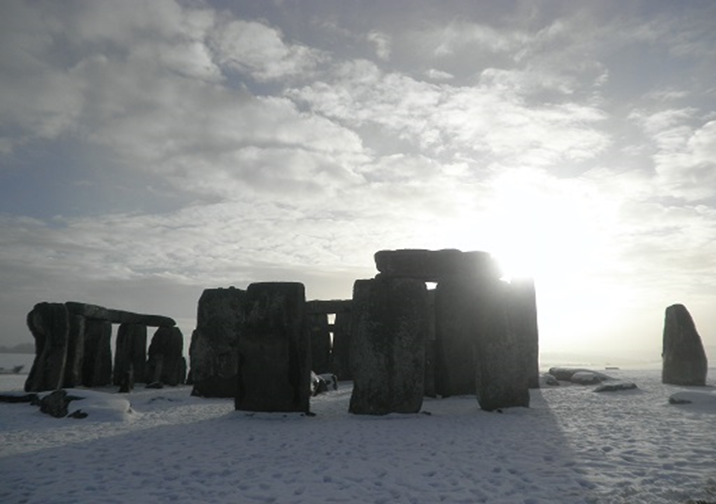By Claire Nolan

Despite a long and persistent tradition of landscape romanticism in Britain, previous critical studies of the ‘rural idyll’ [1][2] have clearly demonstrated that the countryside does not always elicit positive feelings. Whether they represent, amongst other experiences, isolation and loneliness, exclusion, stigma, or fear, rural landscapes can have negative associations for certain individuals and communities. But how does the historic dimension of such landscapes contribute to or combat this experience, and how might personal narratives help to answer this question?
Historic landscapes have generally been touted as a public good, and in recent years a number of studies have sought to establish their potential to support wellbeing [3]. This includes my own qualitative research on the therapeutic value of prehistoric landscapes in Wiltshire, UK, which I carried out with the University of Reading between 2015-2019 [4]. Setting out on my interview fieldwork to understand how residents experience local antiquities such as Stonehenge and Avebury, I anticipated mostly positive accounts, and this was indeed largely the case. However, this expectation was overturned by responses from residents of the Stonehenge area in particular. Although many of the residents I interviewed expressed a deep connection with, and desire to preserve Stonehenge, a small minority revealed that they find it less enamouring, and yet other participant views fell somewhere in between. This, I was to discover, is the beauty and revelatory power of personal narratives of landscape which are, in reality, nuanced, ambiguous, ever-changing and instructive.
Long the subject of art, literature, archaeological investigation and pagan worship, the prehistoric ruins of Stonehenge and its landscape have acquired over the centuries, a seductive aura of mystery and romanticism. In keeping with this popular impression of the site, many of the participants I interviewed, described the sense of peace, contentment, welcome and expansiveness they experience at Stonehenge and its surrounding landscape, whether walking their dogs, working locally or sitting in their back gardens. Additionally, bordering on the realm of the uncanny, a number of participants identified a tangible special ‘feeling’ in the landscape, which they variously perceived to emanate either from Stonehenge or the land itself. More typical of cultural heritage experience, several participants discussed the existential meaning the landscape holds for them through a sense of deep time, permanence, continuity and tradition, and a feeling of connection to origins, past inhabitants, the earth and the cosmos. Overall, many of the participants view the Stonehenge landscape as a valuable resource – a place to walk, be, escape and contemplate the distant past and the present. A couple of participants even reported that due to these benefits, walking in the Stonehenge landscape is essential to their mental wellbeing.

This positive view of Stonehenge, however, is not universal amongst residents. In fact, for some people living in proximity to the Stonehenge landscape, the monument, in its capacity as a popular tourist destination, has become the bane of their lives. Participants holding this view explained that the high volume of tourists that Stonehenge attracts year-round, and the permanent closure of the A344 trunk road to enhance visitor experience, has increased traffic congestion and noise pollution in the area to the degree that it has reduced their quality of life. They likewise explained how the road closure has caused a surge in ‘rat-running’ traffic through local villages which has led not only to ongoing congestion but also traffic-safety issues. Added to these grievances, the participants related how the tourism generated by Stonehenge, in terms of the crowds of visitors that populate the area on a daily basis, and their parked vehicles which obscure the horizon, has ruined the appearance and ambience of the site and its immediate surroundings for them.

The participants expressed that all of these factors have combined to make them feel disconnected from Stonehenge. Furthermore, some feel disenfranchised by the fact that the tourist focus of the site prevents casual entry for local people, who, although entitled to free entry, are still expected to book tickets in advance of their visit like every other visitor. A number of participants intimated that, consequently, they rarely, or in the case of one resident, no longer, visit the site. Ironically, some of these participants acknowledged that when they moved to the area years previously, they were in awe of Stonehenge, an impression which, due to the issues described above, has now been soured.
Yet, on further examination, it became clear that these two stances on Stonehenge were not as black and white as they first appeared. It transpired that, in actuality, most of the participants who experience the site in a negative way, recognise that the problems they associate with it are not the fault of the monument itself. As such, the majority of these participants still appreciate its historic significance and derive enjoyment from walking in the wider Stonehenge landscape. For example, one couple explained that they have mixed feelings in that they still love the monument, just not its commercialization. Conversely, while there were those who expressed that they would feel bereft if Stonehenge was ever to be removed from the landscape, other residents who also feel a strong connection to the site said that, although they would find its removal upsetting, they didn’t think it would change the feel of the area. For these participants, the meaning and magic they associate with the area is tied to the landscape. Some of these residents also suggested that this is how the landscape would have felt prior to the construction of Stonehenge and that perhaps this magical quality was the very reason why the monument was erected there in the first place. Thus, participant experiences appear to be shaped, at least in part, by a mixture of practical and abstract influences.
This study conveys only a small number of in-depth resident views concerning an exceptional rural heritage landscape. However, it provides an insight into the diversity of perspectives that people can possess regarding their historic environment. More specifically, it suggests that, not simply positive or negative, people have complex and contradictory relationships with their surroundings, including their historic environment. The study also highlights how personal narratives may help in the management of heritage landscapes. As I have discussed elsewhere [5], following my interviews in the Stonehenge area, it occurred to me that that cultural resource management and planning processes regarding historic landscapes should always draw on the personal narratives of stakeholders. This practice could even involve reflective, immersive walks in the landscape where residents can convey to each other, heritage practitioners and planners, their intimate knowledge of the area and what is important to them on the ground. Similarly, where heritage landscapes are contested, perhaps the collection of stakeholders’ personal narratives may aid communication, transform conflict, provide co-produced solutions and show that these places are essentially shared landscapes which, if managed collaboratively and sensitively, can be drawn upon to benefit everyone?
[1] Burchardt, J. 2017. ‘The rural idyll: a critique’, in Elson, V. and Shirley, R. (eds.) Creating the Countryside: The Rural Idyll Past and Present. Paul Holberton Publishing, London, 64-73.
[2] Watkins, F. and Jacoby, A. 2007. ‘Is the rural idyll bad for your health? Stigma and exclusion in the English countryside’, Health and Place, 13(4), 851-864.
[3] Reilly, S., Nolan, C. and Monckton, L. 2018. Wellbeing and the historic environment. Historic England report.
[4] Nolan, C. 2019. ‘Sites of Existential Relatedness: findings from phenomenological research at Stonehenge, Avebury and the Vale of Pewsey, Wiltshire, UK’, Public Archaeology, 18(1), 28–51.
[5] Nolan, C. 2021. ‘Landscape as a Common Good: Wellbeing and the Historic Environment’, paper presented for the Uniscape Online Lecture Series 2021, February 2, 2021. https://www.uniscape.eu/event/wdm-lecture-landscape-as-a-common-good/


Brilliant article